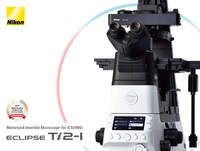- de Change Region
- Global Site
- Home
- Produkte
- Inverse Mikroskope
- ECLIPSE Ti2-I
Customer Interviews
Kundeninterview “Automating adjustments has reduced wrist and arm strain, making long practice sessions much more comfortable.”
The ECLIPSE Ti2-I supports embryologists training at South Korea’s ART Academy
Declining birth rates are a major global issue, and the need for training of embryologists — specialists who handle oocytes, sperm, and fertilized embryos — has become increasingly urgent to help address this problem. The CHA Biomedical Group in South Korea has established the Global CHA Embryolab Academy (GCEA), a specialized institution that systematically trains embryologists to support assisted reproductive technology (ART).
At GCEA, Nikon’s ECLIPSE Ti2-I motorized inverted microscope for ICSI and IMSI plays a vital role for embryologists. Dr. Eun-Kyung Kim, a highly experienced embryologist and director of the Fertility Training Center at the institute, shared insights on the microscope’s operation and the benefits of its implementation.
*This article contains interviews with healthcare professionals regarding our products. However, these interviews do not guarantee the efficacy, effectiveness, or performance of the products, nor do they constitute an official endorsement, recommendation, advice, or selection by the featured professionals.
GCEA is located at Korea’s leading innovation hub
GCEA is a training institution for embryologists that was established by South Korea's leading bio-healthcare group, the CHA Biomedical Group. It is located within the CHA Bio Complex, the group’s core integrated research facility in the Pangyo district — an area often referred to as South Korea’s Silicon Valley. Occupying about 3,550 ft2 (approx. 330 m2), GCEA is South Korea’s first comprehensive, full-scale academy for embryologist training.
The institution is equipped with the latest equipment and technologies used in ART. Practical training is provided in areas including oocyte and sperm collection, embryo culture, embryo biopsy, freezing and thawing, intracytoplasmic sperm injection (ICSI) and preimplantation genetic testing by highly experienced embryologists with over 20 years of expertise. Leading experts from Korea and around the world, including professors of reproductive biology, also offer lectures on the fundamentals of reproductive medicine.
In infertility treatment, ART techniques can increase pregnancy success rates that are normally at levels of 60%, to 70% or higher, with nearly every step depending on the skills of the embryologist. Recognizing the critical role of specialized training in developing these skills, GCEA serves as South Korea’s first advanced facility dedicated to training embryologists. A variety of Nikon microscopes are actively used in its training programs, among which the ECLIPSE Ti2-I motorized inverted microscope for ICSI/IMSI plays a key role. Its automated features — including analyzer and objective lens switching, and light intensity adjustments — support accelerated, efficient learning.
*ICSI is a technique in which a single sperm is injected directly into an egg under a microscope. IMSI (intracytoplasmic morphologically-selected sperm injection) is a method used to select sperm for ICSI.
The ECLIPSE Ti2-I: Reducing the burden of practical training
Until now, South Korea had lacked institutions that systematically trained embryologists. Therefore, when planning the facilities and equipment needed to establish GCEA, there were few precedents to refer to. Consequently, creating an optimal educational environment and developing a curriculum that incorporates the latest equipment required extensive research, planning, and trial and error. Selecting the most appropriate microscopes for practical training was an essential part of that process.
Nikon microscopes were chosen for their high optical performance and precise control functions, which are crucial for observing and handling embryos during infertility treatment. These all-important qualities led to their widespread adoption at GCEA. The ECLIPSE Ti2-I stood out among them not only for its optical excellence, but also for its automated adjustment features, which were expected to significantly enhance the effectiveness of ICSI training by reducing the physical burden on trainees.
We spoke with Dr. Kim about her experience with the ECLIPSE Ti2-I and its performance.
― What led to the decision to adopt the ECLIPSE Ti2-I?
Dr. Kim: “ART is advancing every day. By training with the latest microscope, our trainees gain practical experience with the technologies currently used in clinical settings. That’s why it was essential to equip our ICSI training program with the newest devices. Another factor is that Nikon products are widely used in ART clinics around the world.”
— What are your thoughts on the automated features of the microscope?
Dr. Kim: “In my 36 years of IVF procedure experience, I’ve had to manually adjust the condenser, objective lenses, and light intensity hundreds of times a day. This led to persistent pain in my wrists and arms, but the automated controls of the ECLIPSE Ti2-I have helped to relieve that strain. Now, I can conduct full-day training sessions with much greater comfort. This is more than just for my personal benefit — it also allows trainees to focus better and gain higher-quality experience.”
― How has the microscope status and error notification feature on the display screen been helpful?
Dr. Kim: “It’s very convenient. In ICSI, you’re managing a lot of tasks at once, and mistakes during setting adjustments do happen. But with this function, any errors are displayed immediately, which is very reassuring. It allows me to concentrate fully on the ICSI procedure itself.”
― What do you think about the usability of Nikon’s spindle observation system?
Dr. Kim: “Compared to the previous spindle observation methods, I was amazed that Nikon’s system allows spindle visibility for all oocytes, even under brightfield illumination. It was like stepping into a whole new world. It’s very intuitive and user-friendly. With this technology, oocyte assessment has become more efficient, and I think that ICSI accuracy has improved as well.”
― Do you feel that the ECLIPSE Ti2-I has helped streamline the ICSI workflow at GCEA?
Dr. Kim: “Absolutely. The workflow has become much more efficient. With automated adjustments and intuitive controls, we can work more efficiently and accurately. For example, the automatic switching of the analyzer, polarizer, objective lenses, condenser, and light adjustments has helped to reduce procedure time. The ability to view system status and error notifications on the display in real time has also reduced mistakes. Overall efficiency has improved by around 30 to 40 percent as a result. Trainees have also expressed that using the latest equipment helps them better understand real clinical environments and builds their confidence in preparing for future clinical work.”
Beyond ICSI training, a wide range of Nikon microscopes are used in other practical sessions at GCEA. For instance, the ECLIPSE Ni upright microscope is used for sperm observation and selection, and the SMZ800N stereo microscope is used for oocyte collection. In addition to the ECLIPSE Ti2-I, Nikon’s ECLIPSE Ti2-U IVF inverted microscope supports ICSI training and plays a valuable role in educating the next generation of embryologists.
A global center for ART education and research
In closing, Dr. Kim shared a message for current and future GCEA students: “ART is not only about technical skills. It has the power to bring hope to patients and their families. This makes it a great responsibility and a deeply rewarding path. At GCEA, we provide the latest equipment and training to help you develop the necessary skills for real-world clinical settings. However, beyond technical proficiency, what truly matters is how you apply these skills. If you combine advanced medical knowledge with strong ethical values, you can provide the highest-quality care and bring hope to many more people. I trust that the knowledge and experience you gain at GCEA will serve as a solid foundation for your future.”
She also shared her vision for the future of the institution. “One of our key goals is to bridge the gap between technological advancements in ART and their implementation in training. Currently, GCEA is developing practical, real-world capabilities in embryologists through training programs with cutting-edge equipment. Looking ahead, we plan to increase our global presence by strengthening our connections between South Korea and ART centers around the world. Our mission is to nurture skilled embryologists worldwide and contribute to solving the global challenge of declining birth rates. We hope that GCEA will continue to grow as a world-class center for ART education and research, offering hope to more and more patients globally.”
Nikon is proud to support this vision and the people working every day to shape the future of reproductive medicine.
- Home
- Produkte
- Inverse Mikroskope
- ECLIPSE Ti2-I


